Many of us have experienced pain in the knee while running, jumping, or with stair climbing. Sometimes it happens because of a traumatic injury, but in many cases, the knee pain is gradual and constant.
Before starting any exercise routine, make sure to check with your physical therapist or doctor to test the stability of your knee, especially if you’re experiencing knee pain.
Not all knee pain is alike, so don’t expect a cookie cutter quadriceps exercise like straight leg raise to solve your knee problem.
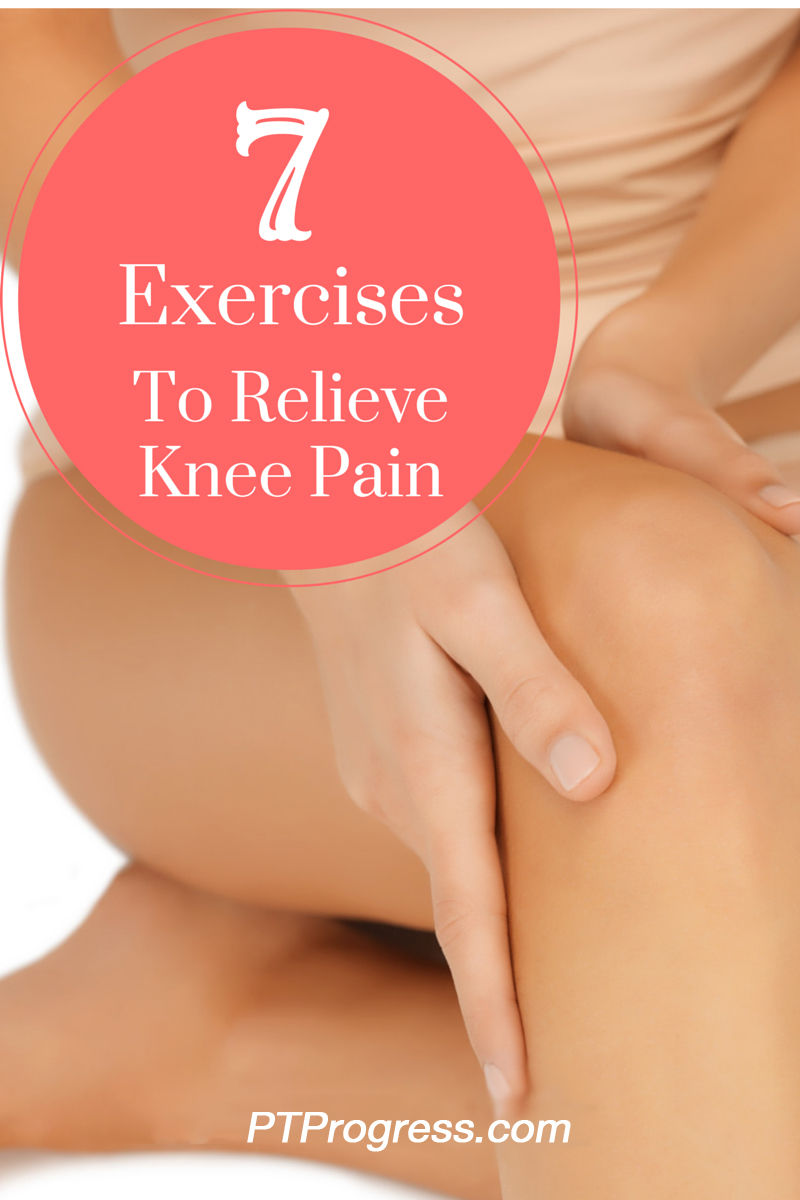
Your quadriceps muscle is probably just fine. For most people with knee pain, it’s the surrounding muscles in the hip and that are really causing the issue at the knee. (Salsich)
Yes, you read correctly. Weakness in the hip can cause a chain reaction of improper alignment in the knee. One of the most common misalignments and causes of knee pain is tibiofemoral rotation.
The name says it all – the tibia (below the knee) is rotated on the femur (above the knee). This malposition of the tibia on the femur can cause knee pain the in the front of the knee and patella femoral pain. Here are two studies that support tibiofemoral rotation as a source of knee pain: Eckhoff and CM Powers.
Wait a minute – I thought you said the hip muscles were the problem, not the tibia, which is below the knee. Keep reading – you’ll see how they’re connected.
Why Do I Have Patellofemoral Pain?
Over time we stress our tissues through movement patterns that can eventually lead to pain and discomfort. Activities like running, dancing, cycling, and swimming can encourage certain motions that rotate the tibia laterally on the femur.
Likewise, the hip joint may be positioned in a more medially or ‘turned in’ position. To compensate, your lower leg (tibia) may turn laterally or ‘outward’ in order to keep your leg straight.
This last paragraph is a key to understanding knee pain.
If we know that rotation is cause of knee pain, then the solution has to come by correcting the movement pattern from the most proximal part – the hip!
If the femur is medially rotated at the hip, we have to strengthen the muscles that laterally rotate the hip. At the same time we can stretch the muscles that medially rotate the hip – i.e. the TFL/IT Band. We’ll save the stretching techniques for another article.
Ok, so let’s take a look at these knee exercises that improve lateral rotation at the hip.
Knee Strengthening Exercises
The key to performing these knee exercises is to focus on precise movements. The number of reps and range of your motion take a back seat to proper form. Each exercise also has specific substitutions that you should avoid.
These exercises should not bring any pain with the knee, so lighten the load or perform one of the lower level exercises to strengthen your knee before progressing.
1. Clamshells – Hip Abduction and Lateral Rotation
Position: Lying on your side, knees flexed to 90˚
Perform: With your knee flexed, rotate your top leg like a hinge keeping your feet together. You should feel the deep muscles below your glutes working.
Posture Correction: Do not let your pelvis rotate backward. Keep your hips vertical and only move your leg to the point where you lose the correct position.
Progression: Perform 10-15 repetitions 2-3 times per day
Lighten the Load: One way to make this exercise easier is to start with a pillow between your knees. This can be a good way to learn how to recruit the deep lateral rotators, especially if they’re really weak.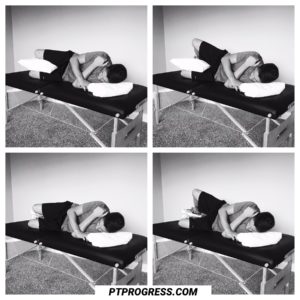
2. Resisted Sidestepping
Position: Standing with resistance bands at ankles
Perform: With your knees slightly bent in a semi-squat, step to the side and follow up with bringing the other leg with you back to the stance position.
Posture Correction: Keep your knee pointed outward. Imaging your knee with a rod sticking straight out of the kneecap – keep this rod pointed outward, never inward. You should feel a contraction behind your thigh deep in your glutes. If you feel the workout in the front of your thigh, try keeping your leg/knee pointed outward to avoid using the wrong muscles.
Progression: Perform 10 steps leading left and 10 leading right. Repeat 2-3 times per day.
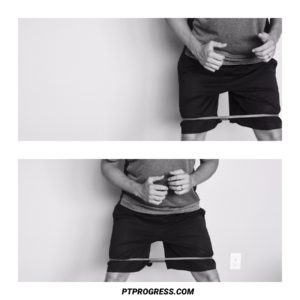
3. Single Leg Stance
This exercise should focus on one main goal: don’t let your hip drop! If you stand on your right leg and your left hip drops, you have weakness in your right gluteus medius and this exercise can be very helpful.
Position: Standing with feet shoulder width apart. Have a countertop for support initially.
Perform: Lift your left leg and stand on your right. You should think about contracting your glutes more than your quads.
Posture Correction: Do not lock out your knee or let it move inward (medially rotate). Keep a soft, slightly bent knee and use the counter as support if you feel your hip start to drop or rotate. Do not let your trunk sidebend or rotate.
Progression: Stand on each leg 10 times for 10 seconds each time.
4. Seated Leg Rotation
Position: Sitting with hip and knees at 90˚ with your feet hanging and not touching the ground.
Perform: By contracting the deep rotator muscles under your glutes, turn your leg so that it rotates your foot outward. Your foot should move like a pendulum, bringing your pinky toe to the sky. You can recruit the correct muscles and get a great workout even without a resistance band. (Yes, this is medial rotation of the femur. During hip flexion, the gluteus medius actually works to medially rotate the thigh. Delp et al.)
Posture Correction: Keep your thigh on the table and your knee at 90 . Your leg should only move a few degrees as you use the glute muscles. Avoid contracting the quadriceps muscles on the top of your thigh.
Progression: Perform 10-15 repetitions on each leg 2-3 times per day. Use a resistance band to progress, keeping good form as you make the exercise more challenging.
5. Glut Max Extension
Position: Lying face down with your knee flexed to 90˚.
Perform: Lift your leg off the table by using your gluteus maximus muscle.
Posture Correction: Avoid arching your back, rotating at your hips, or using your hamstrings as the primary mover. Your glutes should do the work and you should only move as far as you can without any of these substitutions.
Progression: Perform 10-15 repetitions on each leg 2-3 times per day.
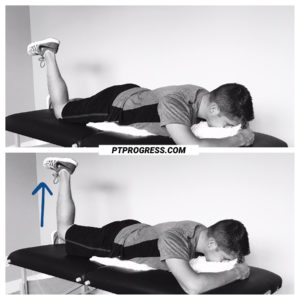
6. Partial Squats With Resistance
Position: Feet shoulder width apart with resistance band above knees.
Perform: Squat down partially while keeping your knees in line with your feet. The resistance band will cue the lateral rotators and glutes to contract as you squat.
Posture Correction: Make sure your knees do not buckle inward. The point of this exercise is to learn how to squat while recruiting the hip lateral rotators so your knees stay aligned over your feet.
Progression: Perform 10-15 repetitions 2-3 times per day.
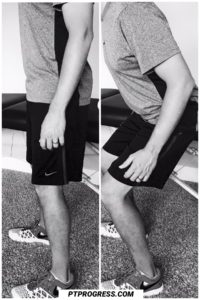
7. Slow Stationary Lunge
Position: Lunge forward with one leg and return back to stance position.
Perform: Contracting the glutes of your stance leg, lunge forward with your opposite leg. Your focus should be on contracting the glutes in the leg that is behind you. Push with the front leg to return to your stance position.
Posture Correction: It’s tempting to use your quadriceps and to perform a deep lunge. Avoid this by focusing on your glutes and only moving as far as you can while maintaining a stable pelvis that does not rotate or drop. Also, keep your knee in line with your foot – do not let it fall inward!
Progression: Perform 10-15 repetitions 2-3 times per day. Perform on various surfaces to increase the intensity, making sure to focus on proper hip position with each movement.
Share your thoughts and knee exercises with others in the comments.


Need diagrams explaining better.
Agreed
Loved your explanation about the root cause of PF pain! I also thought the exercises were really effective. With the exception of #4 seated leg rotation. I ONLY felt that one in the TFL. Not my glutes at all. So concerned that will only exacerbate the problem of tight internal rotators and hip flexors. Thoughts?